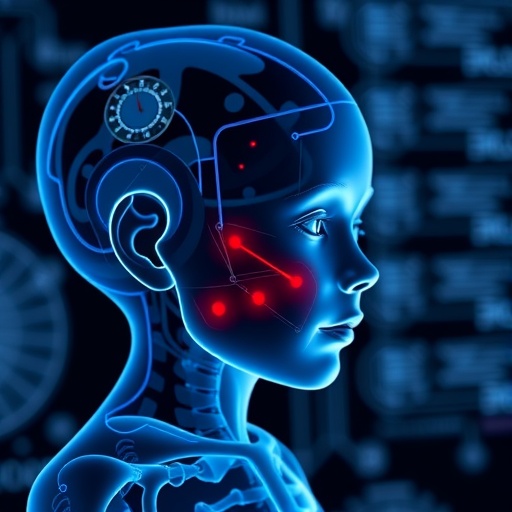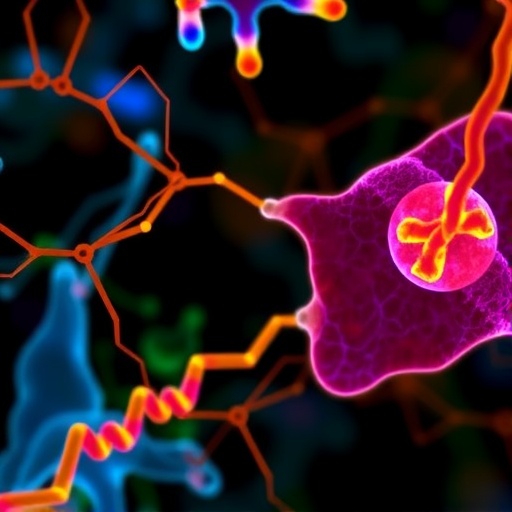
In recent years, the proliferation of artificial intelligence technologies, particularly large language models (LLMs), has prompted a reevaluation of their potential applications in various fields. One area that has drawn significant attention is artificial intelligence’s capacity to assist in medical diagnosis, especially in pediatrics. A recent study published in Pediatr Radiol by Jung, Phillipi, Tran, and colleagues delves into the accuracy of large language models in generating differential diagnoses based on clinical presentations and imaging findings in pediatric cases. This exploration is particularly relevant as healthcare professionals face the increasing burden of complex diagnostic challenges in younger populations.
The study meticulously synthesizes clinical data and imaging findings, leveraging advanced algorithms inherent in large language models. Such models, which have been trained on vast datasets, harness their deep learning capabilities to interpret and analyze multifaceted medical information. The researchers sought to ascertain the effectiveness of these algorithms in generating appropriate differential diagnoses, an essential component of pediatric care. Given the diverse symptomatology often presented by children, an accurate differential diagnosis can significantly impact treatment decisions and subsequent health outcomes.
To conduct this research, the team compiled a dataset of pediatric cases, which included detailed clinical presentations along with corresponding imaging findings. This data was then fed into an advanced large language model designed to facilitate medical analysis. The underlying hypothesis was that these models could not only replicate but potentially enhance the diagnostic capabilities of seasoned healthcare professionals. As the field of pediatric medicine continually evolves, the integration of AI tools presents an innovative approach to addressing both accuracy and efficiency in diagnostic processes.
.adsslot_FHPA4JhB2c{width:728px !important;height:90px !important;}
@media(max-width:1199px){ .adsslot_FHPA4JhB2c{width:468px !important;height:60px !important;}
}
@media(max-width:767px){ .adsslot_FHPA4JhB2c{width:320px !important;height:50px !important;}
}
ADVERTISEMENT
The findings from this study reveal striking insights into the operation of large language models. The model’s ability to generate differential diagnoses proved promising, indicating a solid alignment between AI-generated outputs and expert consensus. Notably, the model exhibited a proficiency in recognizing patterns from both clinical information and imaging data, an essential skill in pediatric diagnostics. The potential to minimize diagnostic errors while speeding up the decision-making process could mark a revolutionary shift in how pediatric patients are assessed and treated.
Additionally, the researchers highlighted that while large language models have shown impressive capabilities, there remain essential considerations regarding their application in clinical settings. Human oversight is paramount; AI should serve as an adjunct to human expertise rather than a replacement. The integration of technology in healthcare has the potential to enhance human capabilities, but careful implementation and validation processes are essential to ensure patient safety.
Moreover, ethical implications arise when considering the use of AI technologies in sensitive fields such as pediatrics. Patient data confidentiality, algorithm bias, and accountability for diagnostic errors are critical issues that healthcare professionals must navigate. The researchers emphasize that a collaborative approach involving technologists, clinicians, and ethicists is crucial to establish robust guidelines and ensure responsible AI use in medicine.
Another integral aspect of this research is the impact of training diverse datasets within large language models. Diversity in training data allows for a more comprehensive understanding of varied medical conditions, particularly in different demographics. The nuances in pediatric presentations across varied races and ethnicities must be considered, ensuring that AI models are effective for the wide range of cases practitioners encounter. Training models using representative datasets can contribute significantly to mitigating bias and improving diagnostic accuracy.
The study results also opened avenues for further inquiry into how AI-driven diagnostic tools can be seamlessly integrated into clinical workflows. Understanding the real-world effectiveness of these models requires rigorous testing within diverse medical environments. Various hospitals and clinics may exhibit different challenges and workflows, necessitating studies focused on user satisfaction, integration time, and overall efficiency in diagnostics. Future research should aim to build a bridge between AI capabilities and everyday clinical practice, ensuring these technologies deliver on their promise.
As pediatricians continue to grapple with the intricacies of child healthcare, the adoption of large language models may represent a step toward ameliorating some traditional bottlenecks in diagnosis. The researchers call for interdisciplinary collaboration to refine these AI tools, focusing on iterative learning and continuous improvement. Through such collaboration, it may be possible to harness the full potential of large language models while maintaining the human element within healthcare.
In conclusion, the study conducted by Jung et al. provides an optimistic glance at the future of pediatric diagnosis through AI. The results indicate that large language models can generate differential diagnoses that align closely with expert assessments, offering a significant aid in addressing the diagnostic challenges faced in pediatrics. As the dialogue surrounding AI in medicine evolves, ongoing research and discussions will be crucial in shaping the future of healthcare, making it more precise, efficient, and accessible for our youngest patients.
The implications of these findings stretch beyond the confines of academia into clinical practice and day-to-day patient interactions. As we continue to integrate advanced technologies in medicine, embracing the potential of large language models may result in enhanced diagnostic capabilities—ultimately improving patient care and outcomes in pediatric healthcare settings.
In sum, the integration of large language models into pediatric medicine exemplifies a thoughtful melding of technology and health sciences. The promise of reducing diagnostic errors and accelerating clinical workflows paints a hopeful picture for practitioners and patients alike. As we embark on this journey, careful attention must be applied to ethical considerations, implementation practices, and the relentless pursuit of improving patient outcomes across populations.
Subject of Research: The accuracy of large language models in generating differential diagnoses from clinical presentations and imaging findings in pediatric cases.
Article Title: Accuracy of large language models in generating differential diagnosis from clinical presentation and imaging findings in pediatric cases.
Article References: Jung, J., Phillipi, M., Tran, B. et al. Accuracy of large language models in generating differential diagnosis from clinical presentation and imaging findings in pediatric cases. Pediatr Radiol (2025). https://doi.org/10.1007/s00247-025-06317-z
Image Credits: AI Generated
DOI: https://doi.org/10.1007/s00247-025-06317-z
Keywords: Large language models, artificial intelligence in medicine, pediatric diagnosis, differential diagnosis, ethical considerations in AI
Tags: accuracy of AI in medical diagnosisadvanced algorithms in diagnosisAI in pediatric healthcareartificial intelligence in clinical settingscomplexities of pediatric diagnosisdeep learning in healthcaredifferential diagnosis in pediatricsevaluating AI in medical practicehealthcare professionals and AIimpact of AI on pediatric treatment decisionslarge language models in medicinepediatric imaging analysis





